Ludofauna: Crabs in Games
Crabs in video games: armored, lethal, and overlooked
Ludofauna is a recurring series on Ctrl+Alt+Decay which analyzes the role of animals in games.
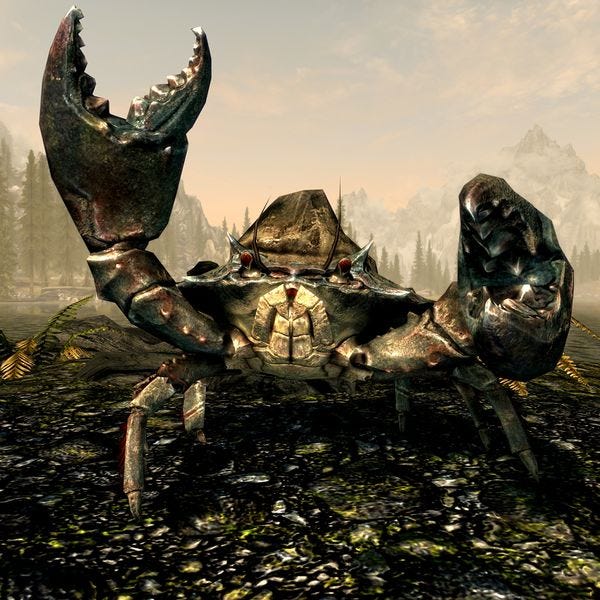
The Best Defense is a Good Offense
In Ludofauna’s last entry, we used the Mega Man and Pokémon franchises to look at moths in games. I’ll try not to lean too hard on these games in every Ludofauna essay, but no promises! It feels like just about every animal has some representation in Mega Man or Pokémon, and the humble crab is no exception. Mega Man X2 gave us Bubble Crab, and who could forget Krabby, first appearing in Pokémon Red/Blue. Both of these crab-inspired video game characters will act as excellent introductions to thinking about crabs in gaming. We’ll start by looking at the types of moves and abilities crabs are usually given, and discuss whether or not that lines up with their real-life anatomy and behaviors.
And… for the most part, yeah, the abilities of crabs in games are pretty obvious—they have a shell, and they have claws. Gaming crabs tend to have a good balance of defensive and offensive capabilities, and this does clearly draw on the real world physiology of crabs. In Mega Man X2, Bubble Crab summons a protective bubble barrier around himself, and also emits spikes of green energy above him, making jumping risky. At first, I thought these green spikes were meant to mimic the rough and sharp ridges of a crab’s shell, but a closer look reveals that the green energy beams clearly take the shape of giant crab claws. Here’s a crab-type enemy utilizing both defensive and offensive techniques in combat. It’s the same with Krabby—his base stats showcase a relatively high attack and defense, with abilities like “Harden,” “Metal Claw,” “Protect,” and “Razor Shell.” Like Bubble Crab, Krabby is equally at home guarding or attacking.
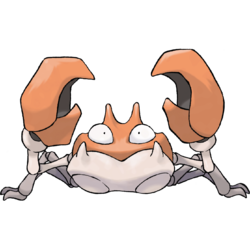
Under the Shell
Indeed, crabs tend to be fairly well-balanced characters in a lot of games. But do any games depict crabs as more than just “shell and claw”? What more can we really learn about crabs from games?
Well, let’s stay with Krabby for just a moment longer, and not just because he’s adorable—he can actually teach us a thing or two about crabs! His Pokédex entry in Pokémon Yellow tells us that if Krabby breaks off a claw in battle, it can quickly grow back. This is also true of real-life crabs, which have the ability to regenerate claws, legs, and sometimes even eyes. Where the fiction differs from reality is in the word “quickly”—in real life, stone crabs can take a year or more to regrow lost claws. And, unfortunately, there are fairly high mortality rates associated with both the physical trauma of declawing and the increased difficulty in eating. Still, a crab’s capacity for regeneration is remarkable.
Besides that, there isn’t a whole lot else that gaming crabs borrow from real-world crabs. They have a strong defense and offense, and once in a while you see the theme of regeneration (although even this is fairly rare). Some video games make a solid attempt to replicate a crab’s sideways style of movement; and, indeed, most crabs in real-life tend to scuttle side-to-side, though there are some, including the spider crab and hermit crab, which prefer forward movement.

There’s more to crabs in nature, though, that video (and tabletop) games could borrow from! There’s a deep diversity of crab species, yet most games seem to model their crabs after either stone crabs or else the most generic “plain crab” that comes to mind. Hermit crabs are probably the next most common kind of crab represented in games, thanks to their unique behavior of scavenging discarded shells and other objects to carry around as added protection. After that, fiddler crabs probably round out the usual trio of crabs you might see in a game—they stand out by having one pincer or claw much larger than the other. The prominent large claw in fiddler crabs is actually a feature of sexual dimorphism in male crabs. As one might expect, the big claw does factor in when it comes to fighting, hunting, and self-defense, but it is also believed to be used for thermoregulation.
It makes sense why these three crabs—hermit, fiddler, and “generic” speciesless crab—are the most frequent flyers in games. The generic crab is what most people think of when they first think of a crab, and serves as a standard variety. Hermit and fiddler crabs each have distinctive attributes which make them easier to adapt into game mechanics in a fun way. But there are other crab species that shouldn’t be ignored—not many games feature the ghost crab, spider crab, yeti crab, coconut crab, orangutan crab, or mole crab, to name a few. Each of these crab species have interesting behaviors and appearances that stand out, and would certainly be suitable for game adaptation.
So, we’ve established that there are a much wider array of crab species in nature than we see in video games. And again, we’ve discussed how crabs tend to be boiled down to their claws, their shells, and maybe their regenerative properties in terms of what gets translated to in-game mechanics. Unsurprisingly, however, there are many crab superpowers in the real world that are rarely if ever programmed into games.
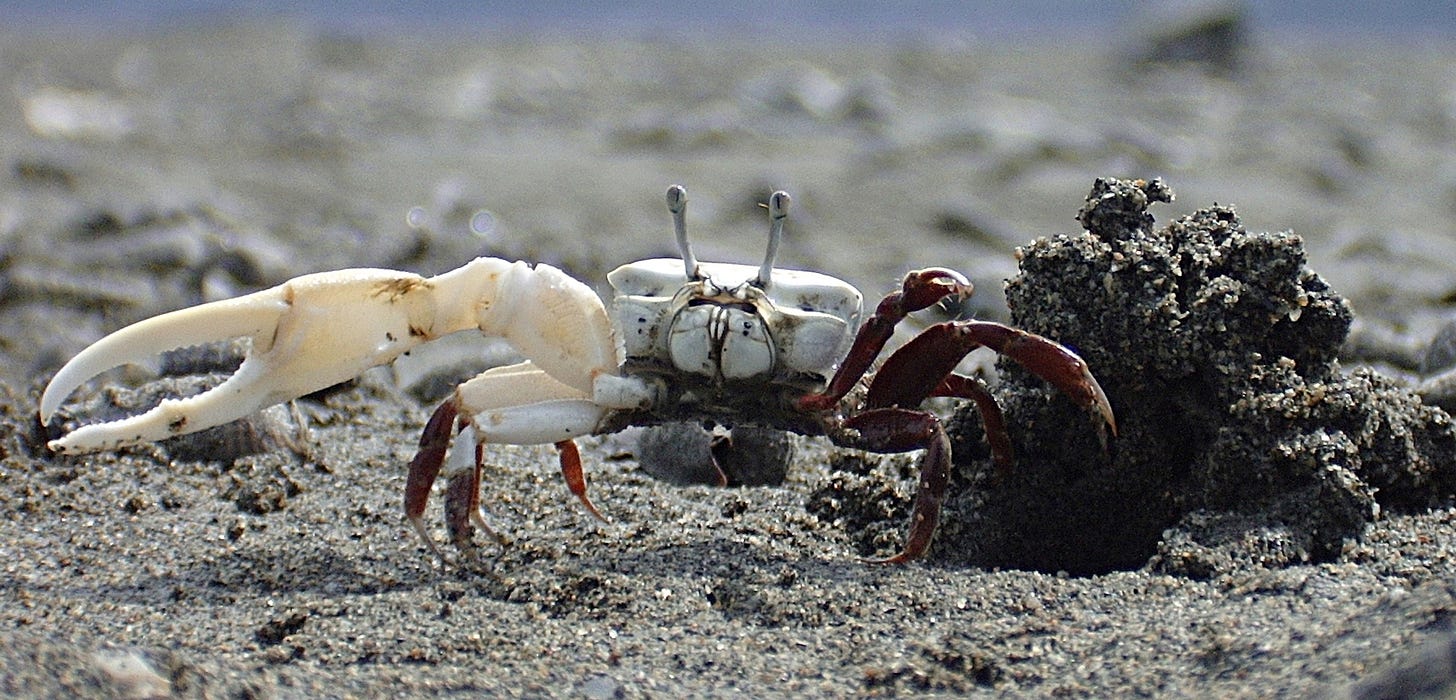
Many, like ghost, fiddler and mole crabs, can burrow under the sand, which could result in a great ambush enemy type. Others (like fiddler crabs, again) are industrious little construction workers, building sophisticated burrows and even above-ground structures out of the sand and other sediments. Other crabs (like, once more, you guessed it—fiddler crabs) have 360 degree vision:
Fiddler crabs are unique in having an omni-directional eye that enables 360-degree vision both underwater and on land. The small creature’s eyes are raised above their heads like a periscope and feature flat corneas; two features that enable this multi-directional vision that means the crab can see around it without having to move its body (Evans, 2022, on IOT World Today; based on the work of Lee et al., 2022)
I leave it to game designers to determine how to interpret these real-world characteristics in their games. But the potential for a more interesting, unique crab entity in gaming is clear.
Giant Enemy Crab
Crabs are interesting because they are usually enemies: aligned with the bad guys, monsters to be slain. Crabs do make for good boss monsters or larger threats than your standard horde-style minion. Game designers can simply scale them up, far beyond any size of crab seen in nature, and the general principles of fighting them remain roughly the same regardless of whether the crab in question is normal-sized or the size of a truck: avoid the claws. Find a way to pierce their armored shell. Giant, menacing claws always make for an imposing threat, and a large crab, especially with its bizarre side-to-side movement can easily serve to block an important path and act as an obstacle to be overcome. The resemblance of these crustaceans to arachnids like spiders makes them seem alien and intimidating for many gamers.
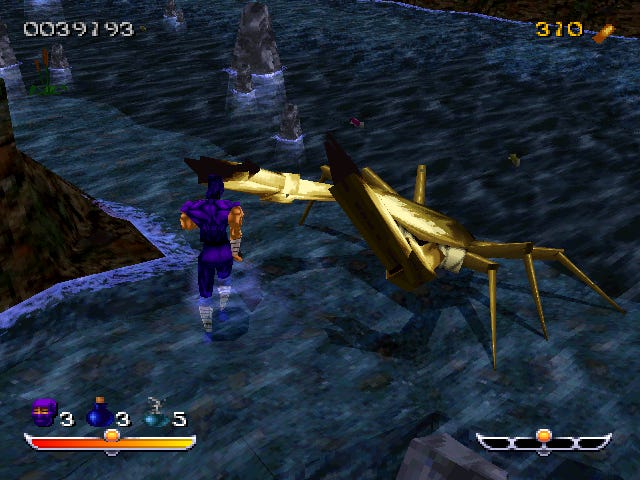
Fairly often, though, they show up as allies in games. World of Warcraft allows hunters to tame crabs as allied pets, granting abilities like claw, cower, growl, and pin. In Kenshi, there exists a faction called the Crab Raiders whom the player can ally with. Nipper, the enormous hermit crab from Banjo-Kazooie, serves as a boss enemy but initially offers to help Banjo.
Crabs in games are truly a balanced and flexible creature—equally capable of offense or defense, equally capable of being friend or foe. And they make for great show-stopping boss fights!
Serve with Garlic Butter

Unfortunately, despite their malleability and potential fulfilling a wide range of roles in games, crabs are most often relegated to relatively plain and unoriginal adaptations. They’re often encountered in the early-game, easy to defeat and forget. In the Elder Scrolls universe, mudcrabs have become something of a joke—an iconic line from Oblivion being the often-repeated line: “I’ve fought mudcrabs more fearsome than you!”
One of the other most common uses of crabs in games is to provide a source of food and crafting materials. If a crab drops loot at all, it’s probably meat. MMOs like World of Warcraft give you a number of quests asking you to kill massive numbers of crabs, to harvest their meat, etc. Accordingly, a number of cooking recipes exist utilizing crab meat, claws, etc. for crafting: crab cakes, cooked crab claws, spiced chili crab, and more!
There’s nothing wrong with crab serving either of these roles; still, I think there’s a missed opportunity. Game designers should find bold and exciting roles for less-often used crab species and overlooked crab behaviors and characteristics. Crabs shine as big boss enemies and should not be limited to low-level fodder. I’d personally love to see more crab allies in games as well—I could even picture a humanoid crab as a quirky party member in a JRPG or CRPG. Developers should find opportunities to make crabs the star of the show (shout out to Another Crab’s Treasure, which does a magnificent job of putting you in control of the hermit crab Kril!).
Crabs have some really strong representation in games; but there’s lots of uncharted waters still out there, waiting to be explored. Please, consider putting some truly memorable crab characters in your games. Don’t let this underappreciated animal continue to flounder.
Further Reading
https://ctrlaltdecay.substack.com/p/ludofauna-moths-in-games
https://en.wikipedia.org/wiki/Declawing_of_crabs
https://myfwc.com/research/saltwater/crustaceans/stone-crabs/faq/
https://www.discoverwildlife.com/animal-facts/marine-animals/why-do-crabs-walk-sideways
https://en.wikipedia.org/wiki/Fiddler_crab
https://en.wikipedia.org/wiki/Emerita_(crustacean)
https://link.springer.com/article/10.1007/s10164-020-00647-1
https://www.iotworldtoday.com/robotics/researchers-develop-artificial-vision-based-on-crab-s-eyes-
https://www.nature.com/articles/s41928-022-00789-9
https://www.wowhead.com/classic/pet=8/crab#tameable
https://wowpedia.fandom.com/wiki/Classic_cooking_recipes



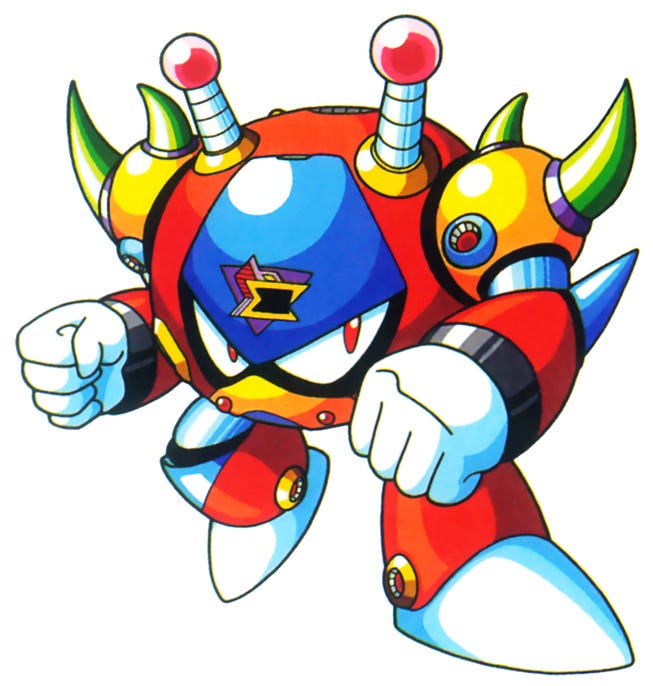
There are definitely worse places to have crabs than in games... 🤔
Ps. Seeing Nipper in Banjo-Kazooie really brings back memories.